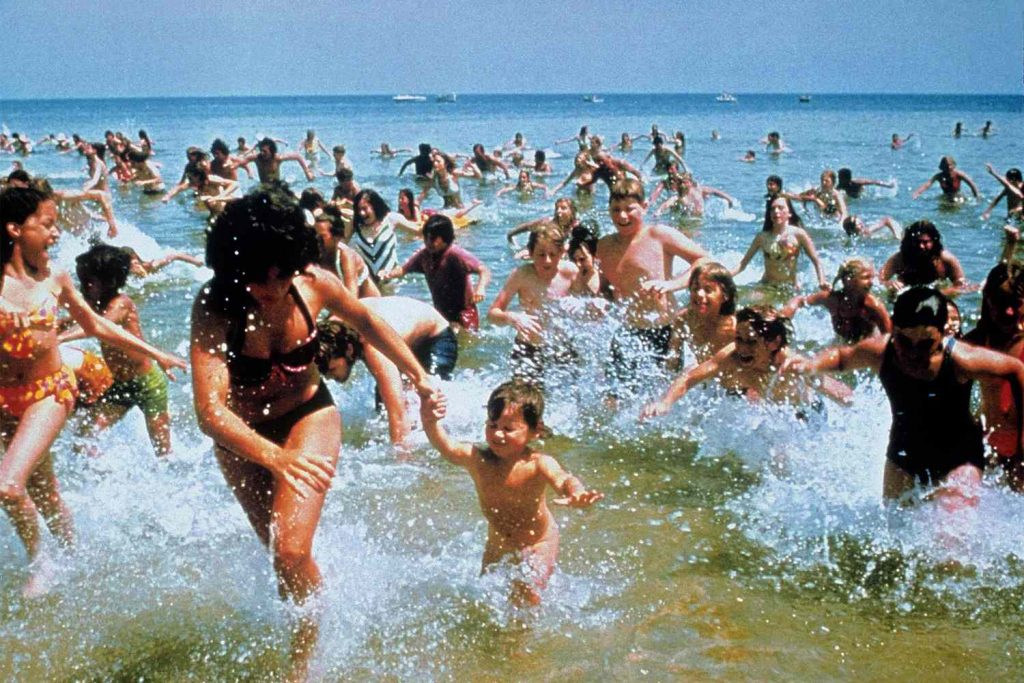Jaws is often seen as the first summer blockbuster. After the first day of shooting began “without a script, without a cast, and without a shark” (to quote actor Richard Dreyfuss), it was an immediate success on its release in the summer of 1975, not only becoming the highest-grossing film to date, but also a major influence on the movie business and on the culture at large.
Jaws is also, significantly, a New England movie. Though the novel that inspired the film was set on Long Island, the working class milieu and tight-knit community of characters rocked by a series of shark attacks transferred well to Martha’s Vineyard. Steven Spielberg’s gift for finding the extraordinary in the everyday took root in the fishing village of Edgartown, and his strong eye for detail gave us an indelible snapshot of island life towards the end of the 20th century.
After directing Duel, which depicted a similar conflict between a man and a leviathan, Spielberg took on Jaws because he wanted to shoot a film at sea. He chose Martha’s Vineyard because it fulfilled many of the technical requirements that making a movie with a mechanical shark required. “It was the only place on the East Coast where I could go twelve miles out to sea and avoid any sighting of land but still have a sandy ocean bottom only thirty feet below the surface, where we could install our shark sled,” he told Vanity Fair in 2023.
Reports about how Vineyard residents received the Hollywood crew differ. In the 1995 documentary Spotlight on Location: The Making of Jaws, producer David Brown recalled that “Martha’s Vineyard didn’t particularly care for a movie invasion. They didn’t like to see an artificial shark parked in a channel where their homes faced it.” This report contradicts both the Martha’s Vineyard Chamber of Commerce, which claims that “the Martha’s Vineyard community was thrilled to have Jaws filmed in their town,” and Martha’s Vineyard Museum curator Anna Barber, who noted, “Every possible aspect of the movie was helped along or supported by island people, whether production, building sets, as extras, to photographing behind the scenes, to acting in the movie, to the characters themselves being informed by Vineyarders.”
The supporting cast of islanders gave the film a sense of authenticity that would make any Masshole proud. The dropped Rs and singsongy cadence of the dialogue makes the Massachusetts accents in Jaws among the best committed to film, and the bubble perms and oversized bifocals on the women of the supporting cast will give viewers of a certain age a Proustian rush. Wardrobe supervisors Robert Ellsworth and Irwin Rose outfitted Murray Hamilton in a series of loud sportcoats, telegraphing his status as an abrasive politician desperate to keep up appearances even before he explains what “Amity” means.
The sense of verisimilitude extended to the names above the title as well. While preparing to play Quint, Robert Shaw worked with Islander Craig Kingsbury on how to play an old sea dog, and he based Quint’s mannerisms on Roy Campbell, who captained a tugboat that supported the crew in the shoots at sea. Shaw’s depiction of the townie fisherman from hell contrasted with the more naturalistic performance of Roy Scheider, whose Police Chief Brody begins the film as an outsider to the island’s culture; his push to shut down the beaches, combined with Scheider’s tightly wound screen presence, is countered by the economic realities of the island and Quint’s raw eccentricity.
Spielberg made Jaws in a 10-year period that attracted productions like The Boston Strangler, The Friends of Eddie Coyle, and The Brink’s Job to Massachusetts. All of those films had a claustrophobic visual sensibility marked by tight shots and brown-heavy color palettes. With its wide-angled seascapes and frequent use of weather-beaten blues and yellows, Jaws has a lighter feel than other films made in the area at the time. As the Orca pulls away from the coast of Amity in pursuit of the shark, Spielberg’s use of aquamarine makes the film feel less light and more desolate; we become aware of how isolated the characters are and how devoted they are to killing this shark.
Jaws wrapped production four months after the crew arrived on the island. No one had any expectations for what was going to happen next; disgruntled crew members had started calling the film Flaws, and Spielberg himself thought his career was over when the film went way over budget. For the islanders, life went back to normal…for a few months, anyway.
The film was a smash hit on its release and has remained one of the most popular movies of the 1970s. Revival screenings have become a regional tradition in New England around the July 4 holiday, and Jaws fans—or “finatics,” as they are known—flock to Edgartown to see shooting locations and visit attractions related to the film. As Bow Van Riper, the research librarian at the Martha’s Vineyard Museum, told NPR: “I don’t think anybody on the island had a clue it was going to go on to become a monster hit, the first summer blockbuster, a movie that people were still talking about 50 years later.”
“Jaws” is streaming on Peacock and is out on 4K UHD in a new 50th anniversary edition.

